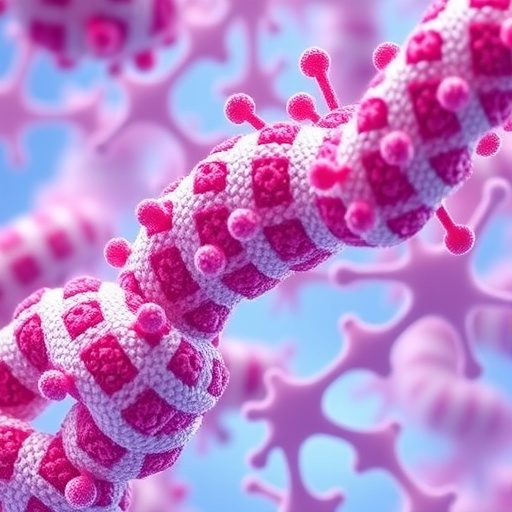In the ever-evolving landscape of molecular oncology, the ubiquitin-specific protease 6 (USP6) has emerged as a multifaceted player with a profound impact on a spectrum of diseases, ranging from benign bone tumors to aggressive cancers and even neurological disorders. Recent breakthroughs have unraveled the enigmatic nature of USP6, illuminating its dualistic role both as an oncogenic driver and a tumor suppressor, and revealing its critical importance in therapeutic interventions. Cutting across diverse biological systems, USP6’s activity orchestrates complex cellular pathways that govern proliferation, invasion, immune regulation, and synaptic functionality, positioning it as a critical node in disease pathogenesis and treatment resistance.
Fundamentally, USP6 is a deubiquitinating enzyme that modulates protein stability by removing ubiquitin tags, thereby controlling the fate and function of pivotal signaling molecules. Genetic aberrations such as chromosomal translocations, leading to USP6 overexpression, have been implicated in tumorigenesis. Notably, USP6-driven oncogenic processes were first characterized in aneurysmal bone cysts (ABCs), benign bone lesions exhibiting aggressive local growth. In these cases, USP6 fusions, especially with gene partners like CDH11, reposition the USP6 gene under the influence of alternative promoters, triggering dysregulated expression and activation of signaling cascades.
The spectrum of USP6-associated pathologies extends well beyond ABCs. Nodular fasciitis, a rapidly growing but benign soft tissue lesion often mistaken for sarcoma, exhibits USP6 rearrangements in nearly all cases, with MYH9 recognized as a predominant fusion partner. The discovery of such recurrent fusion events underscores the neoplastic, rather than reactive, nature of these lesions. Expanding the USP6 tumor family, other fibro-osseous lesions such as fasciitis ossificans, fibro-osseous pseudotumor of digits, myositis ossificans, and soft tissue aneurysmal bone cyst share overlapping genetic and histological hallmarks, driven by USP6 dysregulation. These tumors, characterized by proliferative myofibroblasts and variable osteoid metaplasia, pose diagnostic challenges due to their pseudo-sarcomatoid morphology, blending benign proliferation with features reminiscent of malignancy.
Cranial fasciitis represents another intriguing manifestation of USP6-driven pathology, predominantly affecting pediatric populations. This benign myofibroproliferative condition affects soft tissues and bones of the scalp, manifesting with histologic and molecular parallels to nodular fasciitis. Intriguingly, recent investigations utilizing targeted RNA sequencing have identified novel USP6 fusion partners in cranial fasciitis, including Serpinh1-USP6 and Col3A1-USP6, broadening the mechanistic understanding of this entity. The identification of such promoter-swapping rearrangements offers a refined molecular diagnostic framework, reinforcing a shared pathobiological axis among USP6-associated soft tissue tumors and advancing pediatric oncology diagnostics.
In the context of hematologic malignancies, USP6 has surfaced as a crucial modulator of therapeutic resistance in chronic myeloid leukemia. Its regulatory interplay with glutaminase-1 (GLS1), a key metabolic enzyme, underscores a metabolic adaptation pathway in leukemia cells that fosters resistance to imatinib, a frontline tyrosine kinase inhibitor. By deubiquitinating GLS1, USP6 sustains glutamine metabolism essential for cancer cell survival under therapeutic pressure. Furthermore, microRNA miR-146a-5p mediates this axis, revealing a complex regulatory network involving USP6 that could serve as a target to circumvent leukemia drug resistance.
Remarkably, USP6’s biological versatility transcends oncogenesis, revealing a tumor-suppressive facet particularly evident in Ewing Sarcoma (ES), a pediatric bone malignancy with notorious treatment challenges. USP6 augments the anti-tumor immune milieu by stabilizing JAK1 through deubiquitination, thereby enhancing downstream STAT1 and STAT3 signaling. This cascade results in elevated production of immunostimulatory chemokines like CXCL10 and CCL5, heightening the tumor’s sensitivity to interferons and potentially curbing tumor growth. This dichotomous role of USP6, simultaneously promoting and suppressing tumor progression depending on cellular context, exemplifies the enzyme’s complexity and underscores the necessity for precision therapeutics tuned to tumor-specific molecular signatures.
The multifaceted roles of USP6 emphasize its emerging relevance as a therapeutic target. The molecular precision with which USP6 modulates protein ubiquitination and stability across divergent cellular pathways presents opportunities for intervention, whether to inhibit its oncogenic functions or harness its tumor-suppressive and neuroprotective capacities. The challenge lies in developing strategies that discriminate USP6’s context-dependent effects, as indiscriminate modulation could exacerbate disease or engender unforeseen consequences.
Advances in molecular diagnostics, particularly RNA-based sequencing, have revolutionized the detection of USP6 gene rearrangements, enabling the identification of both known and novel fusion partners across a spectrum of diseases. These diagnostic tools not only refine tumor classification but also guide targeted therapy development. In pediatric soft tissue tumors like cranial fasciitis and nodular fasciitis, such molecular insights are pivotal for distinguishing benign lesions from sarcomas, thus preventing overtreatment.
Future research trajectories are poised to deepen our understanding of USP6’s regulatory networks, illuminating its interactions with ubiquitin ligases, microRNAs, and signaling cascades. For example, the circCYFIP2/USP6/GOLPH3 axis and the miR-146a-5p/USP6/GLS1 pathway exemplify complex molecular circuits ripe for therapeutic exploitation. Additionally, the dual impact of USP6 on tumor immunity and metabolism accentuates its potential as a node for combinatorial therapies integrating immunomodulation and metabolic reprogramming.
In conclusion, the evolving landscape of USP6 biology offers a compelling narrative of molecular duality, therapeutic promise, and diagnostic refinement. From benign bone proliferations and pediatric soft tissue tumors to invasive malignancies and neurocognitive disorders, USP6’s imprint is broad and profound. As scientists continue to decode the intricacies of USP6-mediated regulation, clinical translation beckons, heralding a new era where modulation of ubiquitin pathways shapes the future of precision medicine.
—
Subject of Research: USP6’s role in tumorigenesis, tumor suppression, neurobiology, and therapeutic resistance across various diseases.
Article Title: Physiological roles and therapeutic implications of USP6.
Article References: Syed, S., Painda, M.Y.K., Ghafoor, D. et al. Physiological roles and therapeutic implications of USP6. Cell Death Discov. 11, 231 (2025). https://doi.org/10.1038/s41420-025-02466-0
Image Credits: AI Generated
DOI: https://doi.org/10.1038/s41420-025-02466-0
Tags: bone tumors and USP6cellular proliferation and USP6deubiquitinating enzymes in diseasegenetic aberrations in cancerneurological disorders and USP6oncogenic drivers and tumor suppressorssignaling pathways influenced by USP6therapeutic interventions targeting USP6USP6 and immune regulationUSP6 chromosomal translocations and tumorsUSP6 functions in molecular oncologyUSP6 role in cancer therapy





